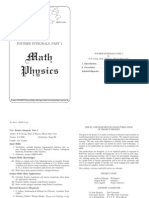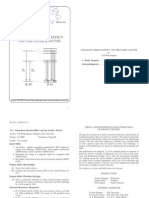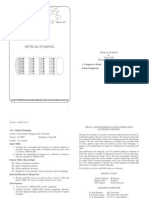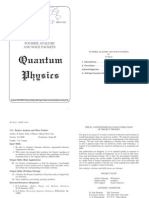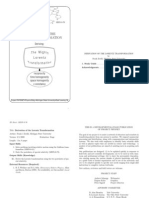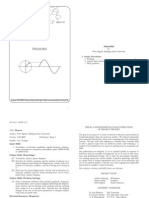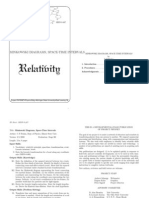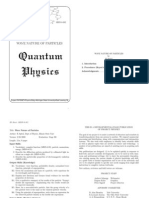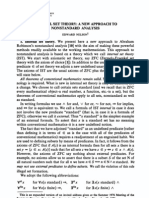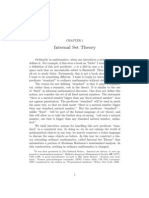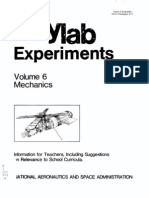Relativity: Einstein'S Field Equations
Relativity: Einstein'S Field Equations
Uploaded by
Epic WinOriginal Description:
Original Title
Copyright
Available Formats
Share this document
Did you find this document useful?
Is this content inappropriate?
Report this DocumentCopyright:
Available Formats
Relativity: Einstein'S Field Equations
Relativity: Einstein'S Field Equations
Uploaded by
Epic WinCopyright:
Available Formats
MISN-0-476
EINSTEINS FIELD EQUATIONS
EINSTEINS FIELD EQUATIONS by C. P. Frahm
Relativity
Project PHYSNET Physics Bldg. Michigan State University East Lansing, MI
1. Introduction . . . . . . . . . . . . . . . . . . . . . . . . . . . . . . . . . . . . . . . . . . . . . . 1 2. Procedure . . . . . . . . . . . . . . . . . . . . . . . . . . . . . . . . . . . . . . . . . . . . . . . . . 1 Acknowledgments. . . . . . . . . . . . . . . . . . . . . . . . . . . . . . . . . . . . . . . . . . . .2
ID Sheet: MISN-0-476 THIS IS A DEVELOPMENTAL-STAGE PUBLICATION OF PROJECT PHYSNET The goal of our project is to assist a network of educators and scientists in transferring physics from one person to another. We support manuscript processing and distribution, along with communication and information systems. We also work with employers to identify basic scientic skills as well as physics topics that are needed in science and technology. A number of our publications are aimed at assisting users in acquiring such skills. Our publications are designed: (i) to be updated quickly in response to eld tests and new scientic developments; (ii) to be used in both classroom and professional settings; (iii) to show the prerequisite dependencies existing among the various chunks of physics knowledge and skill, as a guide both to mental organization and to use of the materials; and (iv) to be adapted quickly to specic user needs ranging from single-skill instruction to complete custom textbooks. New authors, reviewers and eld testers are welcome. PROJECT STAFF Andrew Schnepp Eugene Kales Peter Signell Webmaster Graphics Project Director
Title: Einsteins Field Equations Author: C. P. Frahm, Dept. of Physics, Illinois State Univ. Version: 2/1/2000 Length: 2 hr; 8 pages Input Skills: 1. Unknown: assume (MISN-0-475). Output Skills (Knowledge): K1. Justify the form of the matter tensor M for dust and verify its properties: M = M ; M = 0. K2. Describe briey the general manner whereby the laws of physics (other than those dealing with gravitation) are usually generalized from special relativity to general relativity. K3. Give a plausibility argument for Einsteins eld equations. K4. Summarize the fundamental ideas of general relativity in terms of the eld equations, the geodesic equations and the equivalence principle. External Resources (Required): 1. W. Rindler, Essential Relativity, van Nostrand (1977). Evaluation: Stage B0
ADVISORY COMMITTEE D. Alan Bromley E. Leonard Jossem A. A. Strassenburg Yale University The Ohio State University S. U. N. Y., Stony Brook
Views expressed in a module are those of the module author(s) and are not necessarily those of other project participants. c 2001, Peter Signell for Project PHYSNET, Physics-Astronomy Bldg., Mich. State Univ., E. Lansing, MI 48824; (517) 355-3784. For our liberal use policies see: http://www.physnet.org/home/modules/license.html.
MISN-0-476
MISN-0-476 (Optional) - Read Rindler, bottom of p. 180 to end of chapter 8.
EINSTEINS FIELD EQUATIONS by C. P. Frahm 1. Introduction
In the previous unit the eld equations for vacuum were discussed and a solution of those equations was found for the special case of spherically symmetric static mass distribution. This unit is concerned with the form of the eld equations even in the presence of matter. Once the form of these equations has been determined the formal structure of general relativity is complete.
4. This objective is essentially a review which you are to carry out on your own.
Acknowledgments
The author would like to thank Illinois State University for support in the construction of this lesson. Preparation of this module was supported in part by the National Science Foundation, Division of Science Education Development and Research, through Grant #SED 74-20088 to Michigan State University.
2. Procedure
1. Read Rindler, section 5.13. The objective is to justify eq. 5.49 of Rindler and then prove eqs. 5.50 and 5.51. Comment - Many authors use the symbol T instead of M and refer to T as the energy-momentum tensor or the stress-energy tensor. Comment - Equation 5.49 is valid only for the very special case of dust (a perfect uid). However, eq. 5.50 and 5.51 are assumed to be valid for an arbitrary medium. 2. Read Rindler, section 8.9. Of particular interest are equations 8.120, 8.121, 8.122 and 8.129. Exercise - Propose a generalization consistent with the scheme proposed by Rindler,for extending Maxwells equations and the Lorentz force law to general relativity. Hint: Consult pages 6 and 8 of MISN0-470. Also recall the last exercise on p. 3 of unit MISN-0-473. 3. Read Rindler unit 8.10 to the bottom of p. 180. Exercise - It can be shown (but you need not do it) that the curvature tensor satises Bianchis identities.
R, + R, + R, = 0
Use these identities to verify equation 8.134 in Rindler. Note - The coecient k in Einsteins eld equations (Rindlers eq. 8.136) is at this point completely undetermined. In the next unit it will be shown to be related to Newtons gravitational constant G.
5 6
You might also like
- Physics AKDocument143 pagesPhysics AKyingchen198No ratings yet
- Banked Curves ReportDocument32 pagesBanked Curves Reportfrancisco bordey viernesNo ratings yet
- P1.2 Student Working Scientifically: Falling Cake CupsDocument4 pagesP1.2 Student Working Scientifically: Falling Cake CupsAlenNo ratings yet
- Ch.4 OB AssesmentDocument6 pagesCh.4 OB Assesmentcod5pro100% (1)
- Classical Mechanics: Rigid Bodies The Inertia TensorDocument4 pagesClassical Mechanics: Rigid Bodies The Inertia TensorEpic WinNo ratings yet
- Classical Mechanics: Calculus of VariationsDocument4 pagesClassical Mechanics: Calculus of VariationsEpic WinNo ratings yet
- Classical Mechanics: Vector AnalysisDocument4 pagesClassical Mechanics: Vector AnalysisEpic WinNo ratings yet
- Math Physics: Fourier Integrals: Part 1Document4 pagesMath Physics: Fourier Integrals: Part 1Epic WinNo ratings yet
- Electricity and Magnetism: Electromagnetic WavesDocument4 pagesElectricity and Magnetism: Electromagnetic WavesEpic WinNo ratings yet
- The Gravitational Field: Project PHYSNET Physics Bldg. Michigan State University East Lansing, MIDocument6 pagesThe Gravitational Field: Project PHYSNET Physics Bldg. Michigan State University East Lansing, MIEpic WinNo ratings yet
- M 315Document4 pagesM 315Epic WinNo ratings yet
- Math Physics: Integral Calculus For VectorsDocument4 pagesMath Physics: Integral Calculus For VectorsEpic WinNo ratings yet
- Classical Mechanics: Newtonian Mechanics - Single ParticleDocument8 pagesClassical Mechanics: Newtonian Mechanics - Single Particlep_k_soni_iit_physicsNo ratings yet
- Time-Independent Perturbations: Project PHYSNET Physics Bldg. Michigan State University East Lansing, MIDocument4 pagesTime-Independent Perturbations: Project PHYSNET Physics Bldg. Michigan State University East Lansing, MIEpic WinNo ratings yet
- Formal Structure of QM (Ii) : Project PHYSNET Physics Bldg. Michigan State University East Lansing, MIDocument5 pagesFormal Structure of QM (Ii) : Project PHYSNET Physics Bldg. Michigan State University East Lansing, MIEpic WinNo ratings yet
- Relativistic Energy and Momentum: DerivationDocument4 pagesRelativistic Energy and Momentum: DerivationEpic WinNo ratings yet
- Relativity: Introduction To General RelativityDocument4 pagesRelativity: Introduction To General RelativityEpic WinNo ratings yet
- Optical Pumping: Project PHYSNET Physics Bldg. Michigan State University East Lansing, MIDocument4 pagesOptical Pumping: Project PHYSNET Physics Bldg. Michigan State University East Lansing, MIEpic WinNo ratings yet
- Relativity: Weak-Field Approximation and Gravitational WavesDocument4 pagesRelativity: Weak-Field Approximation and Gravitational WavesEpic WinNo ratings yet
- The SCHR Odinger Equation: Project PHYSNET Physics Bldg. Michigan State University East Lansing, MIDocument5 pagesThe SCHR Odinger Equation: Project PHYSNET Physics Bldg. Michigan State University East Lansing, MIEpic WinNo ratings yet
- Electricity and Magnetism: Review of Vector AnalysisDocument4 pagesElectricity and Magnetism: Review of Vector AnalysisEpic WinNo ratings yet
- Harmonic Perturbations: Project PHYSNET Physics Bldg. Michigan State University East Lansing, MIDocument4 pagesHarmonic Perturbations: Project PHYSNET Physics Bldg. Michigan State University East Lansing, MIEpic WinNo ratings yet
- Relativity: Relativistic Kinematics and Einsteinian OpticsDocument4 pagesRelativity: Relativistic Kinematics and Einsteinian OpticsEpic WinNo ratings yet
- The Numerov Algorithm For Magnetic Field TrajectoriesDocument4 pagesThe Numerov Algorithm For Magnetic Field Trajectoriesp_k_soni_iit_physicsNo ratings yet
- Transitions and Spectral Analysis: Two Slit Images (Two Lines)Document4 pagesTransitions and Spectral Analysis: Two Slit Images (Two Lines)Epic WinNo ratings yet
- Classical Mechanics: Matrices and TransformationsDocument5 pagesClassical Mechanics: Matrices and TransformationsEpic WinNo ratings yet
- Special Relativity: The Michelson-Morley Experiment: FlashlightDocument4 pagesSpecial Relativity: The Michelson-Morley Experiment: FlashlightEpic WinNo ratings yet
- Classical Mechanics: Central Force MotionDocument6 pagesClassical Mechanics: Central Force MotionEpic WinNo ratings yet
- Fourier Analysis and Wave Packets: Project PHYSNET Physics Bldg. Michigan State University East Lansing, MIDocument4 pagesFourier Analysis and Wave Packets: Project PHYSNET Physics Bldg. Michigan State University East Lansing, MIEpic WinNo ratings yet
- Electricity and Magnetism: Maxwell'S EquationsDocument4 pagesElectricity and Magnetism: Maxwell'S EquationsEpic WinNo ratings yet
- Rectangular Potentials: Project PHYSNET Physics Bldg. Michigan State University East Lansing, MIDocument4 pagesRectangular Potentials: Project PHYSNET Physics Bldg. Michigan State University East Lansing, MIEpic WinNo ratings yet
- Classical Mechanics: Driven OscillationsDocument4 pagesClassical Mechanics: Driven OscillationsEpic WinNo ratings yet
- Derivation of The Lorentz Transformation: DerivingDocument4 pagesDerivation of The Lorentz Transformation: DerivingEpic WinNo ratings yet
- Magnetic Fields in Bulk Matter: Magnets: Project PHYSNET Physics Bldg. Michigan State University East Lansing, MIDocument4 pagesMagnetic Fields in Bulk Matter: Magnets: Project PHYSNET Physics Bldg. Michigan State University East Lansing, MIEpic WinNo ratings yet
- Relativistic Energy Reaction Thresholds, Binding EnergiesDocument8 pagesRelativistic Energy Reaction Thresholds, Binding EnergiesEpic WinNo ratings yet
- Electric Field and Potential of Continuous Charge DistributionsDocument10 pagesElectric Field and Potential of Continuous Charge DistributionsMahendra SinghNo ratings yet
- The Dirac Delta Function: Project PHYSNET Physics Bldg. Michigan State University East Lansing, MIDocument4 pagesThe Dirac Delta Function: Project PHYSNET Physics Bldg. Michigan State University East Lansing, MIEpic Win100% (1)
- Phasors: Project PHYSNET Physics Bldg. Michigan State University East Lansing, MIDocument6 pagesPhasors: Project PHYSNET Physics Bldg. Michigan State University East Lansing, MIEpic WinNo ratings yet
- Unified Plasticity For Engineering Applications Unified Plasticity For Engineering ApplicationsDocument125 pagesUnified Plasticity For Engineering Applications Unified Plasticity For Engineering ApplicationsPedroNo ratings yet
- Textbook Functional Analysis in Applied Mathematics and Engineering First Edition Pedersen Ebook All Chapter PDFDocument53 pagesTextbook Functional Analysis in Applied Mathematics and Engineering First Edition Pedersen Ebook All Chapter PDFtiffany.mcintyre649100% (15)
- Relativity: Minkowski Diagrams, Space-Time IntervalsDocument4 pagesRelativity: Minkowski Diagrams, Space-Time IntervalsEpic WinNo ratings yet
- Particles and Interactions: Project PHYSNET Physics Bldg. Michigan State University East Lansing, MIDocument6 pagesParticles and Interactions: Project PHYSNET Physics Bldg. Michigan State University East Lansing, MIEpic WinNo ratings yet
- Mechanical Vibrations Modal Analysis Project With Arduinos: Computers in Education Journal December 2017Document8 pagesMechanical Vibrations Modal Analysis Project With Arduinos: Computers in Education Journal December 2017Crazy FireNo ratings yet
- Math Physics: Conformal MappingDocument4 pagesMath Physics: Conformal MappingEpic WinNo ratings yet
- PHD Course Work Syllabus PhysicsDocument5 pagesPHD Course Work Syllabus Physicsmtywrhajd100% (2)
- Computational Nanomechanics of Materials: Wing Kam Liu, Sukky Jun, and Dong QianDocument27 pagesComputational Nanomechanics of Materials: Wing Kam Liu, Sukky Jun, and Dong QianQaisNo ratings yet
- Math Physics: Boundary Conditions: Vibrating Strings, Heat DiffusionDocument12 pagesMath Physics: Boundary Conditions: Vibrating Strings, Heat DiffusionEpic WinNo ratings yet
- FINITE ELEMENT METHODS IN MECHANICAL ENGINEERING - Lecture1 - Spring2021 - New - StudentDocument56 pagesFINITE ELEMENT METHODS IN MECHANICAL ENGINEERING - Lecture1 - Spring2021 - New - Studentmertdemirtas20No ratings yet
- Numerical Demonstration of Energy Quantization For Atomic HydrogenDocument10 pagesNumerical Demonstration of Energy Quantization For Atomic HydrogenEpic WinNo ratings yet
- Math Physics: Analytic FunctionsDocument5 pagesMath Physics: Analytic FunctionsEpic WinNo ratings yet
- AFEM Ch01Document15 pagesAFEM Ch01Kim NovisNo ratings yet
- Engineering Mechnics Vela Murali 45 PagesDocument45 pagesEngineering Mechnics Vela Murali 45 PagesHackerzilla100% (3)
- tmp32DD TMPDocument10 pagestmp32DD TMPFrontiersNo ratings yet
- Wave Nature of Particles: MISN-0-382Document5 pagesWave Nature of Particles: MISN-0-382Epic WinNo ratings yet
- Functional Analysis in Applied Mathematics and Engineering First Edition Pedersen Download PDFDocument53 pagesFunctional Analysis in Applied Mathematics and Engineering First Edition Pedersen Download PDFtenntorlak100% (1)
- Module 1Document14 pagesModule 1Madelar, Arc Francis C.No ratings yet
- General Physics SylabusDocument5 pagesGeneral Physics SylabusTadesse AbateNo ratings yet
- An Introduction To Continuum Mechanics With ApplicationsDocument19 pagesAn Introduction To Continuum Mechanics With ApplicationsSaman GH.No ratings yet
- Thesis FysicaDocument8 pagesThesis Fysicaafbwrszxd100% (2)
- Applications of Finite Element Analysis For Undergraduates 1Document7 pagesApplications of Finite Element Analysis For Undergraduates 1oai.etu2No ratings yet
- Moments of Inertia, Principal Moments: Project PHYSNET Physics Bldg. Michigan State University East Lansing, MIDocument8 pagesMoments of Inertia, Principal Moments: Project PHYSNET Physics Bldg. Michigan State University East Lansing, MIunknownMYBALLSNo ratings yet
- Proposal AzDocument15 pagesProposal AzwesigashuNo ratings yet
- Conserved Quantities: An Overview: Project PHYSNET Physics Bldg. Michigan State University East Lansing, MIDocument4 pagesConserved Quantities: An Overview: Project PHYSNET Physics Bldg. Michigan State University East Lansing, MIEpic WinNo ratings yet
- Self-Regularity: A New Paradigm for Primal-Dual Interior-Point AlgorithmsFrom EverandSelf-Regularity: A New Paradigm for Primal-Dual Interior-Point AlgorithmsRating: 5 out of 5 stars5/5 (1)
- Warning Signs of A Possible Collapse of Contemporary MathematicsDocument12 pagesWarning Signs of A Possible Collapse of Contemporary MathematicsEpic WinNo ratings yet
- Syntax and Semantics: WWW - Math.princeton - Edu Nelson Papers - HTMLDocument7 pagesSyntax and Semantics: WWW - Math.princeton - Edu Nelson Papers - HTMLEpic WinNo ratings yet
- InequalitiesDocument192 pagesInequalitiesEpic Win100% (2)
- The Mystery of Stochastic MechanicsDocument18 pagesThe Mystery of Stochastic MechanicsEpic WinNo ratings yet
- Mathematics and The Mind: Nelson/papers - HTMLDocument6 pagesMathematics and The Mind: Nelson/papers - HTMLEpic WinNo ratings yet
- RomeDocument7 pagesRomeEpic WinNo ratings yet
- Understanding Intuitionism: WWW - Math.princeton - Edu Nelson Papers - HTMLDocument20 pagesUnderstanding Intuitionism: WWW - Math.princeton - Edu Nelson Papers - HTMLEpic WinNo ratings yet
- Nelson BibDocument5 pagesNelson BibEpic WinNo ratings yet
- IstDocument34 pagesIstEpic WinNo ratings yet
- Edward NelsonDocument1 pageEdward NelsonEpic WinNo ratings yet
- Hilbert's Mistake: Edward Nelson Department of Mathematics Princeton UniversityDocument27 pagesHilbert's Mistake: Edward Nelson Department of Mathematics Princeton UniversityEpic WinNo ratings yet
- HopeDocument4 pagesHopeEpic WinNo ratings yet
- Internal Set TheoryDocument26 pagesInternal Set TheoryEpic WinNo ratings yet
- J. P. MayDocument17 pagesJ. P. MayEpic WinNo ratings yet
- J-Spectra For A Quotient Group J of G. That Context Gives An Interesting SituationDocument9 pagesJ-Spectra For A Quotient Group J of G. That Context Gives An Interesting SituationEpic WinNo ratings yet
- Probability Theory: 1 Heuristic IntroductionDocument17 pagesProbability Theory: 1 Heuristic IntroductionEpic WinNo ratings yet
- 1.07 Projectile MotionDocument42 pages1.07 Projectile Motion011100111100% (1)
- Lec 2-5 Rectilinear and Angular MotionDocument34 pagesLec 2-5 Rectilinear and Angular MotionSaqib SherNo ratings yet
- Answer 2Document6 pagesAnswer 2Stephanie HollowayNo ratings yet
- 2.6 Force (En)Document32 pages2.6 Force (En)Sharlene LarrissaNo ratings yet
- UNIT 14 Time and Timetables Extra Exercises 14.1: MEP: Demonstration Project Teacher Support Y7BDocument11 pagesUNIT 14 Time and Timetables Extra Exercises 14.1: MEP: Demonstration Project Teacher Support Y7BArmando sanchezNo ratings yet
- Section-I (Single Answer Correct Type) : Mumbai / Akola / Delhi / Kolkata / Ghaziabad / Nashik / Goa / Bokaro / PuneDocument7 pagesSection-I (Single Answer Correct Type) : Mumbai / Akola / Delhi / Kolkata / Ghaziabad / Nashik / Goa / Bokaro / PuneBhawna SharmaNo ratings yet
- Skylab Experiments. Volume 6 MechanicsDocument40 pagesSkylab Experiments. Volume 6 MechanicsBob Andrepont100% (2)
- Co-Ordinate Geometry: 2 Change of AxesDocument22 pagesCo-Ordinate Geometry: 2 Change of AxesPrantoNo ratings yet
- Deriving Relativistic Momentum and EnergyDocument15 pagesDeriving Relativistic Momentum and Energyemail4mobileNo ratings yet
- Cam DrawingDocument12 pagesCam DrawingПараг ТамбеNo ratings yet
- Pages From 0625 - s16 - QP - 42 - 01Document2 pagesPages From 0625 - s16 - QP - 42 - 01lelon ongNo ratings yet
- Chapter 7 Rotational Motion - LecturerDocument25 pagesChapter 7 Rotational Motion - LecturerSahira AfuzaNo ratings yet
- Part 02 Questions (84 - 104)Document24 pagesPart 02 Questions (84 - 104)Hamsavardan TNo ratings yet
- WM DFJD ZVSR 3 Pu S0 Ym T9 WDocument19 pagesWM DFJD ZVSR 3 Pu S0 Ym T9 WRangeNo ratings yet
- Civil Engineering Mechanics CVG2149: Kinematics of Rigid Bodies (CH. 15)Document8 pagesCivil Engineering Mechanics CVG2149: Kinematics of Rigid Bodies (CH. 15)Kaiss Nael OsmanNo ratings yet
- Binar Sistem TheoryDocument28 pagesBinar Sistem TheoryDonald Carol0% (1)
- Conceptuals of Rotational MotionDocument4 pagesConceptuals of Rotational MotionSRISHTI SRIVASTAVANo ratings yet
- 01 Test-1 (CH # 1-6) Final PDFDocument4 pages01 Test-1 (CH # 1-6) Final PDFMeher AdeelNo ratings yet
- Analytical Solution of The Geodesic Equation in Kerr - (Anti) de Sitter Space-TimesDocument18 pagesAnalytical Solution of The Geodesic Equation in Kerr - (Anti) de Sitter Space-TimesAttila János KovácsNo ratings yet
- Sankalp - Phase Iv - Gra - 5Document7 pagesSankalp - Phase Iv - Gra - 5Harshit SinghNo ratings yet
- Problem Set VI Lagrangian DynamicsDocument4 pagesProblem Set VI Lagrangian DynamicsDiego ForeroNo ratings yet
- 2 Kinematics in One Dimension PDFDocument14 pages2 Kinematics in One Dimension PDFMarlu PoleroNo ratings yet
- Motion and TimeDocument13 pagesMotion and TimeRajeevSangam100% (1)
- Lewis The Grandfather Paradox 1976Document9 pagesLewis The Grandfather Paradox 1976Ngoc NguyenNo ratings yet
- Newton Laws of Motion - Practice SheetDocument10 pagesNewton Laws of Motion - Practice Sheetrajvardhantalap1474No ratings yet
- Tut 07 SolutionDocument8 pagesTut 07 SolutionDeeptanshNo ratings yet







